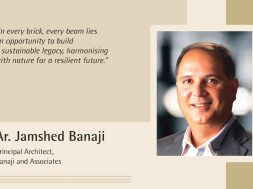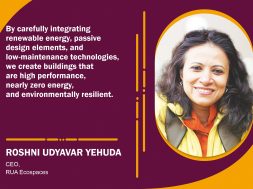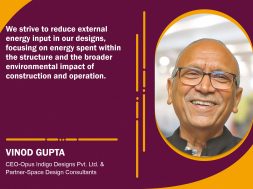Designing spaces for endurance and environmental harmony

In this edition, Ar. Jamshed Banaji, Principal Architect at Banaji & Associates, shares distinct insights on incorporating sustainable principles in design projects that endure and nurture the planet they inhabit.
What sustainable design principles do you prioritise in your projects?
In our design philosophy, sustainability is a cornerstone, guiding every facet of our projects. The principle of material responsibility is paramount, leading us to prioritise eco-friendly, recycled, or upcycled materials that minimise environmental impact. Energy efficiency takes precedence in our projects, with meticulous attention to passive design elements, renewable energy sources, and smart technologies that optimise energy consumption. Further, biophilic design is also woven into our designs, fostering a deep connection with nature. Green spaces, natural light, and incorporating indoor plants create environments that enhance well-being while reducing the ecological footprint. Water conservation is a non-negotiable aspect, integrating innovative solutions such as rainwater harvesting and water-efficient fixtures. Additionally, we meticulously assess and harness the unique potential of each site, maximising natural light, airflow, and landscape features.
What challenges do you face in sourcing sustainable materials, and how do you overcome them?
One of the primary hurdles we face while sourcing is the limited availability of certified sustainable materials, often resulting in a restricted range of options. Additionally, the higher cost associated with sustainable materials poses a financial challenge, making it imperative to strike a balance between ethical sourcing and budget constraints. Navigating the global supply chain complexity is another significant challenge. Moreover, ensuring that materials meet rigorous sustainability standards requires extensive research and verification, demanding an investment of time and resources.
To overcome these challenges, we collaborate and communicate within the industry, establish strong partnerships with suppliers who are committed to sustainability, and facilitate access to a broader range of eco-friendly materials. Embracing innovation and staying informed about emerging sustainable technologies allows us to explore new, cutting-edge options. Furthermore, engaging in transparent communication with clients about the challenges and benefits of sustainable sourcing fosters an understanding and support for dedication to environmentally responsible practices.
How do you integrate green spaces and landscaping to enhance the sustainability of a building or development?
Our commitment to sustainability extends to integrating green spaces and thoughtful landscaping. An impactful approach involves creating green roofs by transforming unused rooftop spaces into flourishing gardens. This provides insulation, reduces energy consumption, and mitigates the urban heat island effect. Further, incorporating biophilic ideas like vertical gardens or living walls is another innovative method to enhance sustainability. These verdant installations improve air quality by filtering pollutants and serve as natural insulation, reducing the building’s reliance on artificial climate control. Ultimately, including native plant species in landscaping fosters biodiversity and promotes efficient resource use.
What strategies do you use to optimise building energy efficiency, considering factors such as insulation, lighting, and HVAC systems?
Optimising energy efficiency involves using top-notch insulation materials to minimise heat transfer, ensuring a consistent indoor climate year-round. This reduces energy consumption and promotes a sustainable and comfortable living or working space. Transitioning to energy-efficient LED fixtures, strategic window placement for natural light, and smart lighting controls contribute to substantial energy savings. Regular maintenance of HVAC equipment and smart controls for consumption optimisation enhance efficiency. Zoning systems improve efficiency by tailoring temperatures based on occupancy and specific area needs.
For more info visit: https://banaji.com/
19
Cookie Consent
We use cookies to personalize your experience. By continuing to visit this website you agree to our Terms & Conditions, Privacy Policy and Cookie Policy.










